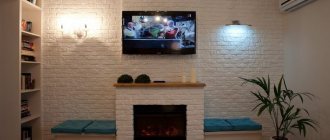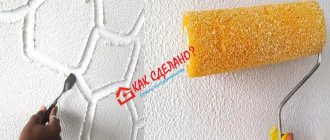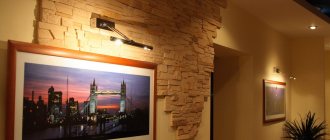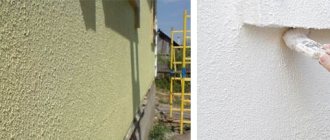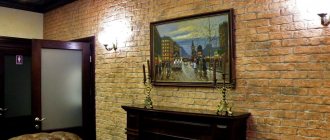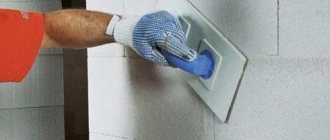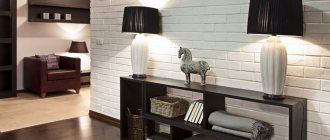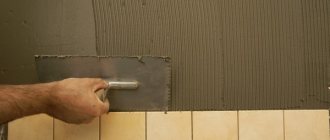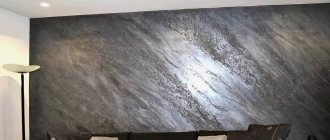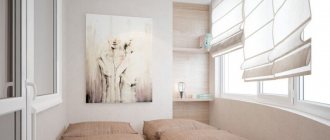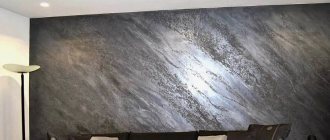Features of the material
Laying gypsum tiles under brick is a great way to replace real stone. Such material will retain heat better and at the same time it will be easy to install with your own hands. That is why decorative stone is used in many interiors.
It has the following distinctive features:
- The material is durable and resistant to all external factors. Gypsum bricks for interior decoration do not suffer from exposure to moisture and mechanical shock, which also indicates the durability of the material;
- Lighter than regular brick. The decorative stone contains plastic elements that make it lighter than the original brick. This contributes to a wide range of uses of the material and ease of installation;
- Cheaper in price. The price of gypsum stone is always much less than that of ordinary brick. This allows you to save on repairs and maintain your budget.
It is these features that cause the frequent choice of gypsum stone as a material for finishing a room. It is easy to install and affordable, which is not the case with all materials.
Gypsum stone in the hallway Source 2proraba.com
How to choose?
For street decoration, this finishing option will be unacceptable. For external decor, a similar material was invented - gypsum cement tiles, visually indistinguishable from gypsum tiles. Therefore, if you set out to improve the exterior of your home, take the trouble to find out about the composition of finishing materials in more detail.
Materials that imitate bricks are increasingly used for interior decoration. Masonry goes well with many styles, and due to the variety of colors and textures, the question of choosing a specific finishing material arises.
If your room is designed in a loft style, then a large space, at least one wall, should be occupied by brick. The color should be as close as possible to the color of natural brick - all possible shades of the ocher-red spectrum. The size of the bricks is approximately 6 by 12 centimeters.
The romance of village life is best emphasized by the combination of brick and wood. A brick wall could be painted to imitate lime over the textured exposed bricks.
Brick goes well with the Gothic style - wrought iron elements and massive furniture, stained glass windows and a fireplace. Decorative plaster and crystal chandeliers will also fit quite harmoniously into such an interior.
Minimalism is characterized by large areas of masonry and a minimum of details. Bright color accents are welcome.
The decorative texture, reminiscent of a brick, is a worthy alternative to textured wallpaper with a “brick effect”, decorative plaster, plasterboard, real bricks, and their facing options.
It is possible to make tiles yourself. For this you will need a plaster mixture, a silicone mold, a flat surface, colors, matte acrylic varnish, brushes and a spatula. If you follow all the recommendations for making the product, you will never have problems choosing the piece of masonry you are interested in.
Composition of gypsum stone
This material contains gypsum for decorative stone. It is the main element in the composition. But besides this, other components are added to the working solution:
- marble chips;
- sand;
- different dyes;
- slaked lime;
- other additives that depend on the type of material.
Decorative products differ from each other in composition, therefore their level of strength and wear resistance is also different. Water purified from destructive impurities is also added to the solution. The resulting mixture is poured into molds and remains in them until completely hardened.
Tips and tricks
Gypsum tiles are a specific material that has both significant advantages and significant disadvantages. Some weaknesses can be modified with the help of special impregnations applied to the finished product, and various additives are added to gypsum tiles at the production stage.
Gypsum is a material with excellent qualities, but it has two significant drawbacks, which the bulk of efforts are directed towards combating. This is fragility and poor moisture resistance combined with high moisture absorption.
At the stage of creating a mixture for tiles, to increase strength, substances are added to the composition that affect the properties of gypsum tiles. Accordingly, the effect from them is maximum. Thus, tiles intended for places where there is constant contact with the finished surface, for example, door portals, corridors, waiting rooms and the like, must necessarily contain components that enhance its resistance to impact loads and abrasion.
Superplasticizers are a group of chemical additives that promote accelerated hardening of gypsum mortar using less water. Thus, the content of the binder in the composition increases, which makes its frozen form more durable. In addition, plasticizers improve the homogeneity of the mixture.
Modifiers are a broad group of substances that can enhance various properties of gypsum tiles: strength, resistance to weather conditions, water resistance and moisture absorption, wear and frost resistance.
If you already have gypsum tiles on hand, it is also possible to strengthen its structure by treating the surface with various substances. This effect has an additional impact on the quality of the product; however, it is necessary in cases where the operating conditions of the tile are particularly aggressive.
Among them are:
- Polymer impregnations. Due to the fact that gypsum is very porous in nature, which makes it brittle, its surface absorbs various substances well. To enhance strength, polymer compounds are used, for example, acrylic-based.
- Painting. This method helps strengthen the surface of the gypsum tiles, protecting them from scratches and preventing moisture from entering through the protective layer created by the hardened dye. Water-based acrylic varnish is often used for this purpose.
- Treatment with vitriol. Just like polymer impregnations, it strengthens the structure of gypsum tiles, penetrating into the pores of the substance. Both copper and iron sulfate are used. Along with increasing strength, the product is given a characteristic shade - copper gives blue, and iron gives yellow. The soaking procedure should last about two hours.
The ability of gypsum tiles to absorb moisture is also modified both during production and can be reduced for finished products. The composition, which contains waterproofing additives, can already be used for kitchens and bathrooms, but only in those places where there is no direct contact with water, for example, covering a bathtub or the area around the washbasin is not recommended.
Types of gypsum bricks for interior decoration
Decorative gypsum bricks are divided into several types. A wide selection of types of such finishing materials allows you to choose a stone for any interior. Before making a final choice between the presented options, you need to familiarize yourself with the features of each building material.
crushed brick
Such gypsum bricks resemble an uneven and rough surface. Can be compared to natural stone mined in the mountains. The coating, made in the form of chips, is used mainly in corridors, offices and public buildings. The technology for producing such a stone is quite complex, since it is necessary to make the surface uneven before the solution has time to dry.
Custom tile Source roomester.ru
Sawn gypsum tiles
The surface of this material is also uneven, but it does not look rough. You can see specially made chips and cracks on it, which add coziness to the interior. They are mainly used in the kitchen as an apron over cabinets. The composition is denser than that of crushed brick, but the edges are smoother.
See also: Catalog of companies that specialize in finishing and small forms
Rubble stone
This type of gypsum stone resembles boulders. The surface is close to the real material. It is smoothed, but with slight roughness. The corners of the stones are rounded, there is a small distance between them. This option most closely resembles natural material, which adds aesthetics to the room.
Free form
This option can combine several types and methods of laying decorative bricks. Here it is allowed to alternate rough and smooth stones, to compare small and large materials with each other. This way the designer will be able to find a unique and interesting design or decoration option for the building both inside and outside. It is used mainly for the design of art objects and is almost never used in residential premises.
Decorative tiles Source 2proraba.com
Figured gypsum tiles
The only type from the category of these building materials that does not try to create an imitation of stone or brick. Figured tiles are a relief and patterned ornament that can be made in all sorts of shapes. Also, 3D panels are now being actively introduced, characterized by visible volume and an interesting design solution.
Advantages and disadvantages
Gypsum bricks for interior decoration are a very good choice as a building material. It is unpretentious in installation and further use. Also among the advantages are the following aspects:
- contains environmentally friendly components that do not adversely affect the human body;
- a wide selection of types of finishing materials allows you to choose a stone for any room;
- gypsum brick has good sound insulation properties and does not allow heat to pass through;
- the material is treated with a special fire-retardant compound, so in case of an emergency it will not ignite;
- ease of installation and installation, you can do it yourself without the help of specialists;
- low price compared to other wall finishing materials;
- You can lay it on any surface, and gypsum tiles will last for many years and will not chip.
Interior ideas
The finishing material gypsum brick is an excellent option for the interior design of any room. Today there are many options for using it in design, the most common of which are:
- In the living room.
A great option is to decorate wall surfaces with decorative bricks in warm colors, such as sand shades. The atmosphere will become cozy when you place a corner, large-sized sofa and a small coffee table against the backdrop of a brick wall. A wall decorated with bricks, complemented by elements of the same material in the corners in the shape of a column, will look more organic; A great option is to decorate wall surfaces with decorative bricks in warm colors, such as sand shades. - In the corridor.
Partial decoration in the form of wall edgings and light-colored baseboards will make the corridor more spacious; Partial decoration in the form of wall edgings and light-colored baseboards will make the corridor more spacious. - In the bedroom.
A brick wall free of furniture with a restrained color scheme or in 2 colors of white and sand looks ideal. To add originality, you can use products with an aging effect against the background of furniture made of natural wood and glass decor. A brick wall free of furniture with a restrained color scheme looks ideal.
Tools for laying gypsum-based tiles
Laying gypsum tiles under brick is carried out according to established rules. In order for the installation to be carried out correctly, it is necessary to follow all the stages and not miss anything. First, you should prepare the tools that you will need during the work process. If some elements are missing, you can easily purchase them in a special hardware store.
To install gypsum tiles you will need the following tools:
- hacksaw;
- building level;
- glue brushes;
- file;
- pencil;
- roller;
- primer;
- tile adhesive.
Additional materials may be required as installation progresses; this is just the basic set required.
Negative points
The material is not very resistant to humidity, that is, it is not necessary to carry out work in rooms that have very high humidity, since gypsum quickly becomes unusable.
Gypsum tiles are used only in rooms with low humidity
At high temperatures, gypsum deteriorates quite quickly. Surfaces located near heating pipes should not be decorated with tiles. It is better not to decorate fireplaces with this material in situations where they do not have an additional layer of protection. It is better to clad the interior; the facades should not be covered with plaster.
Return to content
Installation features
The quality of laying the future gypsum surface depends on each stage. Therefore, it is worth approaching installation work with all responsibility. Laying gypsum tiles requires careful preparation and well-formulated materials. Only in this case will the material be used for a long time. Let's look at each step separately.
Laying tiles with your own hands Source sense-life.com
Video description
This video shows the installation of decorative gypsum stone:
Step 3. Laying tiles
It is important to properly prepare the adhesive composition first. It should be mixed until a thick mass is formed. The glue is applied loosely to the place where the tiles will be laid. The material itself is pressed tightly against the wall and held for a few seconds. It is better to remove residues and excess glue immediately using a special sponge.
Laying gypsum tiles under brick begins from the bottom corner, gradually moving to the central part. It is better to immediately lay out the stones in even rows without gaps or gaps, so as not to cover them with grout later. After installation, you can paint the joints with paint to match the color of the material to restore the original appearance, matching the base material.
Step 4. Checking the general condition
After the installation of all the tiles has been completely completed, it is worth assessing the general condition of the gypsum material. It is important to monitor each joint so that the distance between the tiles is not too large. If necessary, go through the grout again. If everything was done correctly, the gypsum stone will last a long time.
Laying gypsum tiles Source krrot.net
Grouting joints
A day later, when the adhesive has set and hardened, you can begin grouting the joints. Grouting process:
- The seams can be filled with adhesive.
- The top of the seam is filled with paste using a construction syringe or a bag with a cut corner.
- The formation of the seam is done using a wooden stick or a cut plastic tube. Then it will have a convex shape.
Grouting joints of gypsum brickwork - The seams should only be painted after the grout has dried.
- The seams are painted using a brush and acrylic paint.
To take into account all the intricacies of the work and avoid mistakes, it is worth watching the video.
Briefly about the main thing
Gypsum for decorative stone is used in almost every modern design. This material is a budget and modernized version of conventional brick. It is lighter, easier to install and suitable for all types of surfaces. That is why when choosing an artificial surface, attention is paid to gypsum stone.
A large assortment allows you to choose the material for each room. But the types are very different from each other, so it is worth studying in detail the properties of each and comparing them with the technical characteristics of the room. You can do the installation yourself, but it is important to follow all the rules and strictly follow the instructions. Only then will gypsum tiles become an excellent addition to the interior of the house.
Ratings 0
